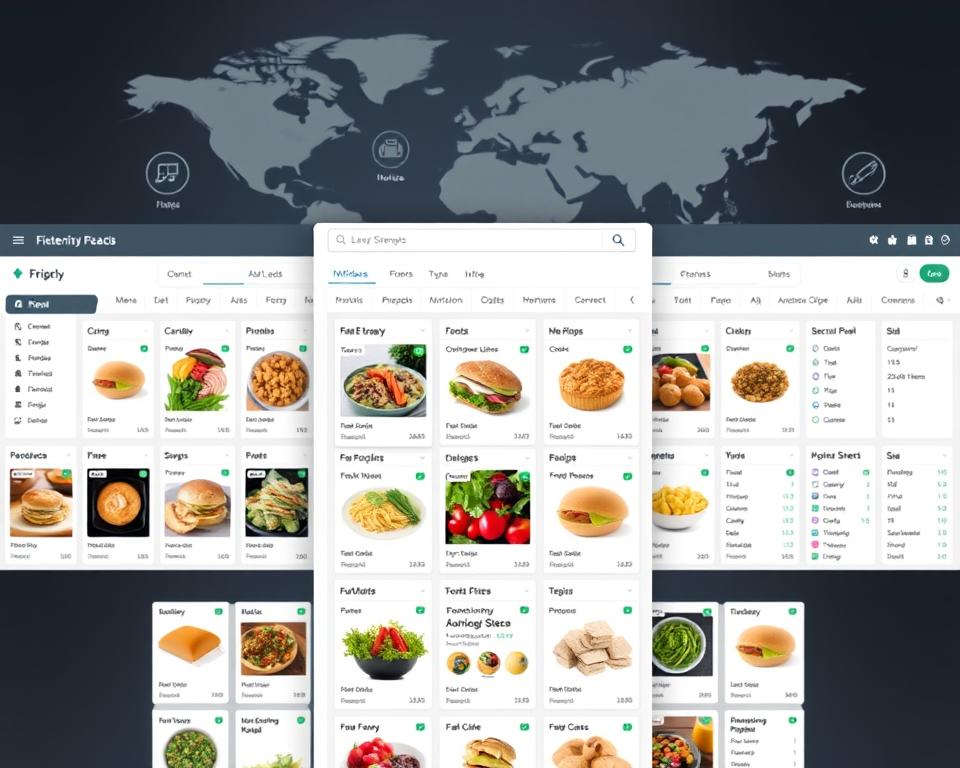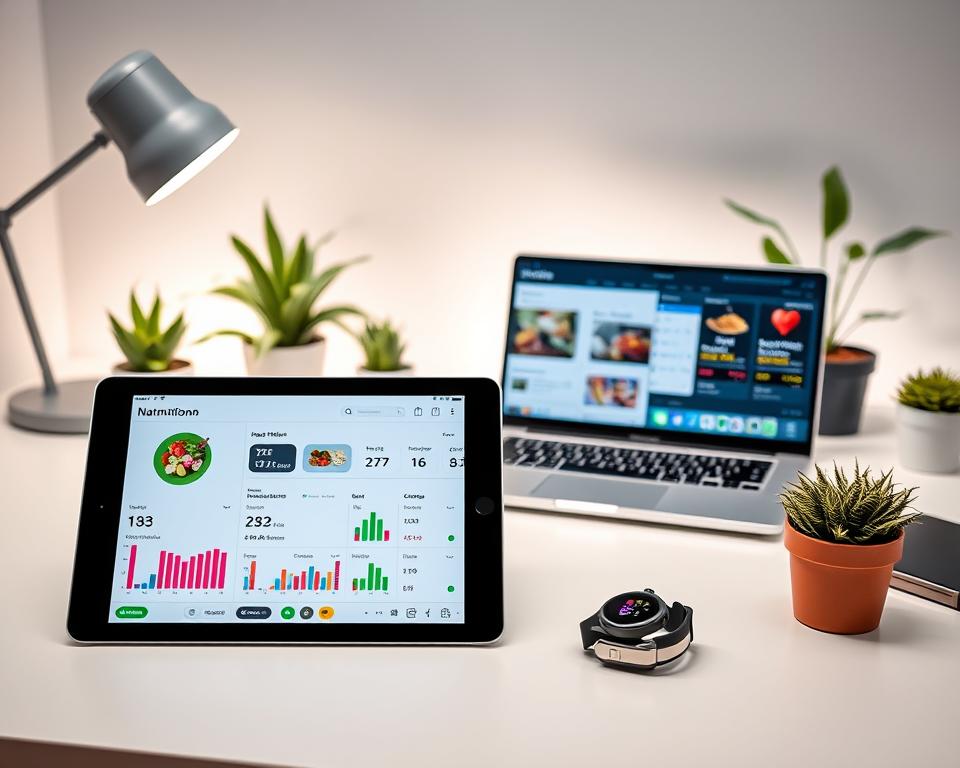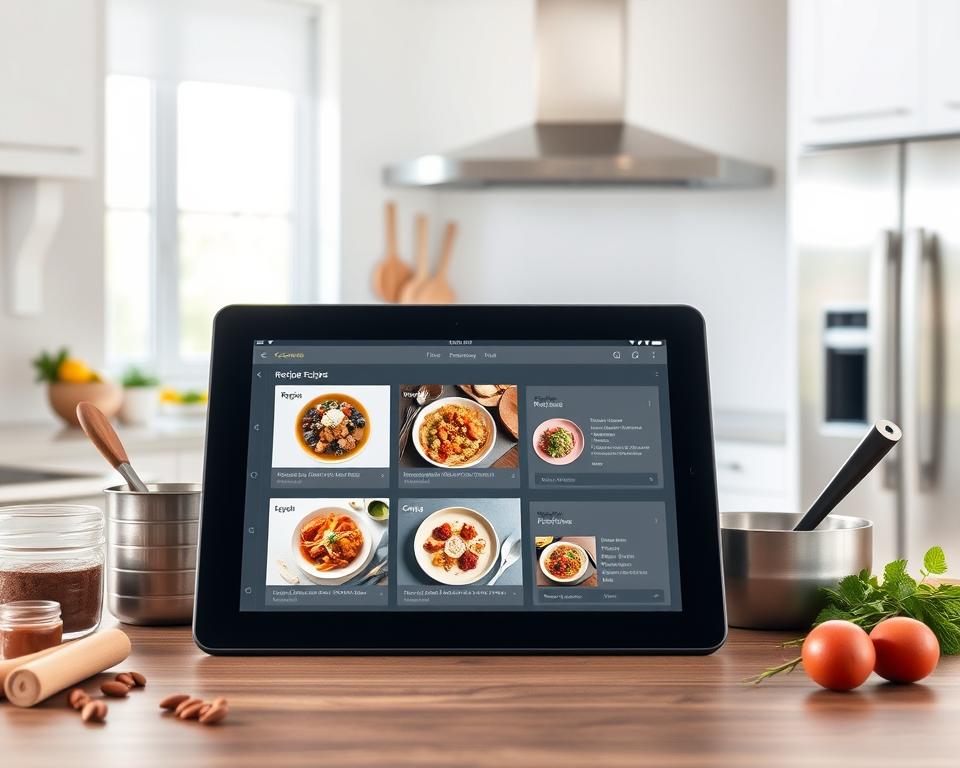To create a diet and nutrition app like MyFitnessPal, you need to know the market well. The app market is expanding fast. It’s key to understand the current size and growth of the diet and nutrition app market.
Developing such an app means making it easy to use. It should track calories and analyze nutrition. Also, it must keep user data safe and follow all rules.
The nutrition app market is very competitive. To stand out, your app must meet your audience’s needs. This means doing market research and understanding who your users are.
By knowing how to develop a diet and nutrition app, you can make one that people will use and keep using.
Table of Contents
Key Takeaways
- Understand the diet and nutrition app market and its growth potential
- Conduct market research to identify target audience demographics
- Develop a user-friendly interface with essential features such as calorie tracking
- Ensure data security and compliance in the app development process
- Integrate features that cater to the needs of the target audience
- Analyze user feedback to improve the app and increase user retention
- Stay up-to-date with the latest trends and developments in the nutrition app market
Understanding the Diet & Nutrition App Market
The nutrition app market is booming, with more people looking for healthy eating and fitness apps. To make a successful app, knowing the market size and growth is key. The market is now around $1.4 billion and is growing at 15% each year.
Big names in the market include MyFitnessPal, Lose It!, and Calorie Counter. Understanding your competition and who your app is for is crucial. A good app should offer personalized meal planning, calorie tracking, and nutrient analysis. These features help your app stand out.
Here are some important facts about the nutrition app market:
- The market is expected to reach $1.9 billion by 2025
- 70% of users prefer apps with personalized recommendations
- 60% of users track their daily calorie intake using a nutrition app
By grasping the nutrition app market and adding key features, you can make an app that meets user needs and shines in the market.
| Feature | Description |
|---|---|
| Personalized meal planning | Provides users with customized meal plans based on their dietary needs and preferences |
| Calorie tracking | Allows users to track their daily calorie intake and set goals for weight loss or maintenance |
| Nutrient analysis | Provides users with detailed analysis of their daily nutrient intake, including macronutrients and micronutrients |
Essential Features of a Successful Nutrition App
A top-notch nutrition app needs a wide range of features to keep users coming back. It should have a comprehensive food database with over 1 million entries, a calorie tracking system, and a nutritional analysis tool. These are key for giving users the right info to make smart diet choices.
When making a nutrition app, think about the technical requirements for diet apps. This includes the backend and frontend tech. A good app is easy to use and has a friendly interface. Some must-have features include:
- A big food database with all the nutritional details
- A calorie tracker to keep an eye on daily intake
- A tool for personalized nutrition advice
By adding these successful nutrition app features and meeting the technical requirements for diet apps
| Feature | Description |
|---|---|
| Food Database | A huge database with over 1 million food entries |
| Calorie Tracking | A system for tracking daily calorie intake |
| Nutritional Analysis | A tool for personalized nutrition advice |
Technical Requirements for Building a Diet & Nutrition App Like MyFitnessPal
To make a diet and nutrition app like MyFitnessPal, you need to think about the technical side. A strong backend is key to manage lots of user data well. You’ll need a cloud-based backend, a frontend tech like React Native, and a database like MySQL.
A good diet app needs a big, updated food database. It should give users the right info on what they eat. This helps users make better diet choices. You also need a database that keeps user data safe and can grow with the app.
- Backend infrastructure: cloud-based platform, scalable and secure
- Frontend development technology: React Native, user-friendly and responsive
- Database management system: MySQL, reliable and efficient
- Food database system: comprehensive and up-to-date, providing accurate nutritional information
By focusing on these tech needs and a solid food database, developers can make a great diet app. It will be easy to use and meet user needs, giving it a strong market position.
Creating a Robust Food Database System
A comprehensive food database system is key for a diet and nutrition app. It gives users accurate and reliable nutritional info. This system needs a vast list of foods, detailed nutritional data, and a simple search function.
To build such a system, collecting and integrating a lot of data is essential. It’s all about accuracy and reliability.
The food database system should work with user authentication and profile management features. This lets users save their favorite foods and track their nutrition. It makes the app more personal and engaging.
A good food database system can have over 1 million foods listed. It includes detailed nutritional info and a search function that’s easy to use.
Some important features of a strong food database system are:
- A big list of foods with detailed nutritional info
- A search function that’s easy for users
- Works with user authentication and profile management
By making a strong food database system, a diet and nutrition app can give users the info they need. This helps them make better choices about their diet and lifestyle. It makes the app more useful and fun to use, helping it succeed.
Implementing User Authentication and Profile Management
Building a diet and nutrition app requires a secure user authentication and profile management system. It should let users register and log in easily. It must also protect their data well.
Users should be able to customize their profiles. This includes setting dietary goals and tracking progress with a calorie tracking interface. The interface should be easy to use and give accurate data.
When setting up user authentication and profile management, consider these points:
- Secure password recovery system
- Easy-to-use registration and login process
- High level of data privacy and security
- Customizable user profiles
A strong user authentication and profile management system is key. It makes diet and nutrition apps secure and reliable. It also helps users reach their dietary goals with a calorie tracking interface.
A well-designed system is vital for a diet and nutrition app’s success. It builds trust and loyalty with users.
Designing the Calorie Tracking Interface
A good calorie tracking interface is key for a diet app. It must be easy to use, precise, and dependable. The app should track calories, listing foods and their nutrition.
Some important features of a calorie tracking interface are:
- Easy-to-use food diary
- Comprehensive database of foods and their nutritional information
- Personalized recommendations and insights
Nutritional analysis tools are also vital. They offer users tailored advice and insights. This helps them make better diet choices.
With a friendly calorie tracking interface and nutritional tools, a diet app can offer a full and personal experience. It helps users reach their health and wellness goals.
| Feature | Description |
|---|---|
| Calorie Tracking | Track user calorie intake |
| Nutritional Analysis | Provide personalized recommendations and insights |
Integrating Nutritional Analysis Tools
When making a diet and nutrition app, adding nutritional analysis tools is key. These tools help users get personalized advice and insights. They can track their intake of nutrients by using a big list of foods and their nutritional data. For more on making nutrition apps for individuals, check out this resource. It shows how to make diet plans that fit each person’s needs.
A recipe management system is also vital. It lets users find lots of recipes and see their nutritional info. This is great for planning meals ahead and staying on track with dietary goals. Some important parts of a recipe system include:
- Comprehensive recipe database
- Nutritional information for each recipe
- Meal planning and grocery list features
With nutritional analysis tools and a recipe management system, a diet app can offer a full and personal experience. It helps users reach their health and wellness goals.
| Feature | Description |
|---|---|
| Nutritional Analysis | Provides users with personalized nutritional recommendations and insights |
| Recipe Management | Enables users to access a wide range of recipes and their corresponding nutritional information |
Building the Recipe Management System
A good recipe management system is key for a diet and nutrition app. It should list recipes and their nutritional info. The app should also suggest recipes based on what you like, making sure they’re accurate and reliable.
Some important features of a recipe management system include:
- Ability to add and customize recipes
- User-friendly interface
- Focus on data accuracy
Adding social features and community engagement can also improve the app. This could be through social sharing, forums, and ways for users to interact. A supportive community helps users stick to their diet plans.
A recipe management system, social features, and community engagement make a diet app better. They offer a wide range of recipes, tailored suggestions, and a supportive community. This helps users reach their diet goals and live a healthy life.
| Feature | Description |
|---|---|
| Recipe Management System | Comprehensive list of recipes with nutritional information |
| Social Features | Social sharing, community forums, user interaction features |
| Community Engagement | Supportive and engaging community to help users achieve dietary goals |
Incorporating Social Features and Community Engagement
Creating a diet and nutrition app like MyFitnessPal is more than just listing food and exercises. It’s about building a community that supports and motivates users. This is where social features and community engagement play a big role. They offer a space for users to share their progress, connect with others, and get personalized advice.
By adding social features and community engagement, developers can keep users coming back. They also encourage users to pay for premium features and subscription models.
Some important features to think about include social sharing, community forums, and ways for users to interact with each other. These help users feel part of a community and motivated to succeed in their diet and nutrition goals. By using social features and community engagement, developers can build a loyal user base. This loyal base will help the app grow and make more money.
To really stand out, developers can add premium features and subscription models. These can include personalized coaching, customized meal plans, and exclusive content. By offering different options, developers can meet various user needs and increase the app’s appeal and earnings.
- Social sharing capabilities
- Community forums
- User interaction features
- Premium features and subscription models
By including these features and models, developers can make a complete and engaging diet and nutrition app. This app will meet user needs and help the business succeed.
Developing Premium Features and Subscription Models
Creating a diet and nutrition app means offering premium features and subscription models. These help users get more support and motivation. They should add value, focusing on data security and compliance. Examples include personalized coaching, advanced nutritional analysis, and customized meal planning.
To make premium features and subscription models work, consider these points:
- Offer various subscription plans to meet different needs and budgets.
- Keep users interested with regular updates and new features.
- Make sure data security and compliance are top-notch with strong encryption and secure storage.
By adding premium features and subscription models, diet and nutrition apps can boost user engagement and keep them coming back. This leads to more revenue. It’s key to balance user value with data security and compliance. With the right strategy, these features can make your app stand out, leading it to the top of the market.
Apps like MyFitnessPal have seen great success with premium features and subscription models. They’ve grown their revenue and user base significantly. By focusing on data security and compliance, developers can build a thriving diet and nutrition app.
| Premium Feature | Description |
|---|---|
| Personalized Coaching | Customized coaching and support from certified nutritionists |
| Advanced Nutritional Analysis | Detailed analysis of user’s nutritional intake and recommendations for improvement |
| Customized Meal Planning | Personalized meal plans based on user’s dietary needs and preferences |
Ensuring Data Security and Compliance
When making a diet and nutrition app, keeping user data safe is key. It’s important to make sure the app follows rules and keeps user info secure. This builds trust and confidence in the app.
The app should meet HIPAA standards. It should use strong encryption and safe storage for user data. This makes sure the app follows rules and keeps user data safe.
Key Considerations for Data Security
- Implementing robust data encryption methods to protect user data
- Utilizing secure storage solutions to safeguard sensitive information
- Conducting regular app testing and quality assurance to identify and address potential security vulnerabilities
By focusing on data security and following strict testing and quality checks, developers can make a trustworthy app. This app will meet user needs and keep their data safe.
App Testing and Quality Assurance
When making a diet and nutrition app, app testing and quality assurance are key. They make sure the app works well, is stable, and safe. This means testing it a lot to find and fix bugs, so users can trust it.
A good marketing and user acquisition strategy is also vital. It helps reach and keep the app’s target audience. This can include things like making the app stand out in stores, using content to attract users, and keeping them coming back.
Some important things to think about for app testing and quality assurance include:
- Doing detailed beta testing with different kinds of users
- Having a strong way to get and use feedback to solve problems
- Following all the rules and standards that apply
By focusing on app testing and quality, and having smart marketing and user acquisition strategies, developers can make a great diet and nutrition app. It will meet the needs of its users.
Marketing and User Acquisition Strategies
Creating effective marketing and user acquisition strategies is key for a diet and nutrition app’s success. A good marketing plan should include app store optimization to boost visibility and downloads. This means optimizing the app’s listing with the right keywords, making the icon catchy, and encouraging reviews.
Having a solid launch strategy and deployment plans is also vital. This includes a content marketing plan that offers valuable content like blog posts, social media updates, and email newsletters. This approach helps keep users engaged and interested. Some effective strategies for keeping users include:
- Personalized recommendations and insights
- Regular updates with new features and content
- Engaging social media campaigns
By using these strategies, a diet and nutrition app can attract and keep users. This leads to the app’s success.
Launch Strategy and Deployment Plans
A good launch strategy and deployment plans are key for a diet and nutrition app’s success. They outline steps before, during, and after launch. This includes marketing, user engagement, and a summary of the app’s main points.
Some important things to think about include:
- Identifying the target audience and making a marketing campaign that speaks to them
- Coming up with ways to keep users engaged with the app
- Creating a summary of the app’s main points and takeaways
With a solid launch strategy and deployment plans, a diet and nutrition app can have a successful launch. For more on making a perfect mobile app, check out this link.
The launch strategy and deployment plans should make users excited and eager. Transparency is crucial for building trust. A well-thought-out launch strategy helps achieve this.
In conclusion, a well-planned launch strategy and deployment plans are vital for a diet and nutrition app’s success. They ensure a smooth and exciting launch for users.
| Launch Strategy | Deployment Plans |
|---|---|
| Define target audience | Develop user engagement strategy |
| Create marketing campaign | Provide user support |
Conclusion
Creating a diet and nutrition app like MyFitnessPal needs careful thought. You must have a strong food database, an easy-to-use interface, and personalized advice. The success of fitness apps shows the importance of a well-thought-out plan.
Focus on key features, understand the market, and use new tech like AI and blockchain. This way, you can make an app that stands out and meets user needs.
To make a successful app, know your market and audience well. Follow the tips in this article and keep up with the latest in health and fitness app trends. This will help you succeed and offer value to your users.
In short, put users first, add cool features, and keep their data safe. This way, you’ll create an app that motivates and keeps users coming back. It’s a recipe for a successful business.
FAQ
What is the current market size of the nutrition app market?
FAQ
What is the current market size of the nutrition app market?
The nutrition app market is worth about
FAQ
What is the current market size of the nutrition app market?
The nutrition app market is worth about $1.4 billion. It’s growing at 15% each year. This growth is driven by more people wanting diet and nutrition apps.
What are the essential features of a successful nutrition app?
A good nutrition app needs a big food database and calorie tracking. It should also have nutritional analysis. The app must be easy to use, with a simple interface.
What are the technical requirements for building a diet and nutrition app like MyFitnessPal?
To make a diet app like MyFitnessPal, you need a strong backend. This includes a scalable database and secure frontend tech. React Native and MySQL are good choices.
How do I create a robust food database system for my diet and nutrition app?
Building a solid food database takes a lot of data collection. It must be accurate and reliable. Include over 1 million foods with detailed nutrition info and a user-friendly search.
What are the key considerations for implementing user authentication and profile management in a diet and nutrition app?
User authentication and profile management are key. You need a secure login system. Users should be able to customize their profiles, focusing on data privacy and security.
How do I design a user-friendly calorie tracking interface for my diet and nutrition app?
A good calorie tracking interface must be accurate and reliable. It should track calorie intake and offer nutritional analysis tools. Personalized recommendations are important.
What are the benefits of integrating nutritional analysis tools in a diet and nutrition app?
Nutritional analysis tools are crucial. They provide personalized recommendations and insights. They help calculate nutrient intake and offer progress tracking.
How do I build a recipe management system for my diet and nutrition app?
A recipe management system is essential. It should have a list of recipes and their nutritional info. Personalized recipe recommendations are key.
What are the key considerations for incorporating social features and community engagement in a diet and nutrition app?
Social features and community engagement are vital. They provide a supportive community. Users can share progress and connect with others.
How do I develop premium features and subscription models for my diet and nutrition app?
Premium features and subscription models are important. They offer additional support and value. Personalized coaching and advanced analysis are examples.
What are the key considerations for ensuring data security and compliance in a diet and nutrition app?
Data security and compliance are critical. Protect user data and follow regulations. HIPAA compliance is important. Use data encryption and secure storage.
How do I ensure the quality and reliability of my diet and nutrition app through testing and quality assurance?
Quality and reliability come from thorough testing. Identify and fix bugs. Rigorous testing builds trust and confidence.
What are the key considerations for developing a marketing and user acquisition strategy for my diet and nutrition app?
A solid marketing strategy is crucial. Reach and engage your audience. Use app store optimization, content marketing, and retention tactics.
How do I develop a launch strategy and deployment plan for my diet and nutrition app?
A well-planned launch is essential. Include marketing, promotion, and user engagement. Aim for a smooth and exciting launch.
.4 billion. It’s growing at 15% each year. This growth is driven by more people wanting diet and nutrition apps.
What are the essential features of a successful nutrition app?
A good nutrition app needs a big food database and calorie tracking. It should also have nutritional analysis. The app must be easy to use, with a simple interface.
What are the technical requirements for building a diet and nutrition app like MyFitnessPal?
To make a diet app like MyFitnessPal, you need a strong backend. This includes a scalable database and secure frontend tech. React Native and MySQL are good choices.
How do I create a robust food database system for my diet and nutrition app?
Building a solid food database takes a lot of data collection. It must be accurate and reliable. Include over 1 million foods with detailed nutrition info and a user-friendly search.
What are the key considerations for implementing user authentication and profile management in a diet and nutrition app?
User authentication and profile management are key. You need a secure login system. Users should be able to customize their profiles, focusing on data privacy and security.
How do I design a user-friendly calorie tracking interface for my diet and nutrition app?
A good calorie tracking interface must be accurate and reliable. It should track calorie intake and offer nutritional analysis tools. Personalized recommendations are important.
What are the benefits of integrating nutritional analysis tools in a diet and nutrition app?
Nutritional analysis tools are crucial. They provide personalized recommendations and insights. They help calculate nutrient intake and offer progress tracking.
How do I build a recipe management system for my diet and nutrition app?
A recipe management system is essential. It should have a list of recipes and their nutritional info. Personalized recipe recommendations are key.
What are the key considerations for incorporating social features and community engagement in a diet and nutrition app?
Social features and community engagement are vital. They provide a supportive community. Users can share progress and connect with others.
How do I develop premium features and subscription models for my diet and nutrition app?
Premium features and subscription models are important. They offer additional support and value. Personalized coaching and advanced analysis are examples.
What are the key considerations for ensuring data security and compliance in a diet and nutrition app?
Data security and compliance are critical. Protect user data and follow regulations. HIPAA compliance is important. Use data encryption and secure storage.
How do I ensure the quality and reliability of my diet and nutrition app through testing and quality assurance?
Quality and reliability come from thorough testing. Identify and fix bugs. Rigorous testing builds trust and confidence.
What are the key considerations for developing a marketing and user acquisition strategy for my diet and nutrition app?
A solid marketing strategy is crucial. Reach and engage your audience. Use app store optimization, content marketing, and retention tactics.
How do I develop a launch strategy and deployment plan for my diet and nutrition app?
A well-planned launch is essential. Include marketing, promotion, and user engagement. Aim for a smooth and exciting launch.


















